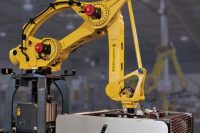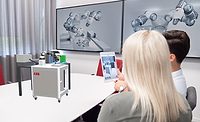Just like Rosie the robot maid from the 1960s cartoon “The Jetsons” helped the Jetson family with the housework and sometimes the parenting to ease the pressures of home life, robots in the beverage industry are helping to make industrial life a bit easier. The key to their helpfulness is the flexibility they offer, which helps manufacturers keep up with the changing beverage landscape, says Matt Job, business unit manager of Hartness International’s automation group in Greenville, S.C. “With the ability to handle greater numbers of product variants, smaller case counts, and lighter-weight packaging/packaging material, end-users are able to meet the trends that are moving across the market,” he says.
For example, Hartness’ High Speed Robotic Palletizers were designed to help increase overall line efficiency for lightweight packages as well as the smaller-count packages that are high in demand, Job says. The company also offers a flexible Variety Pack Product Mixing System, which is designed to build mixed-case solutions at a high rate while utilizing a small footprint, he adds.
Robots also can help to simplify systems by handling the work of multiple machines or equipment with one robot, says John Barry, vice president of sales and marketing for the Americas at ITW Warehouse Automation (ITWWA), Arden, N.C. For example, the company’s VTP palletizers feature integrated, layer-forming robots that accurately orient each case into its proper position, eliminating the need for slat dividers and bump turns, he says. This, in turn, reduces packaging damage through gentler handling and requires minimal changeover between products and configurations, he adds.
The challenge for any type of palletizer — whether conventional, robotic or human — is the Tetris-like puzzle that mixed-case building presents. “You basically have a 3-D puzzle that you’re trying to build,” explains Dick Motley, senior account manager for robotic packaging at Fanuc America, Rochester Hills, Mich. “A human that’s doing that job is doing so many complex evaluations in their head, they’re almost pre-planning and fitting the puzzle together in their head,” he says.
Mason, Ohio-based Intelligrated’s robotic palletizers use a form of logic to solve this puzzle, says Matt Wicks, vice president of controls and software engineering for manufacturing systems. “We’re using advanced cubing algorithms to determine the stacking patterns for mixed-SKU pallets,” he explains. The algorithms take into account factors like product size and weight as well as whether or not it can be stacked on top of another product in order to build a stable load and maximize the cubing of the pallet, he says.
Improvement 101
Not only are robotics smart enough to solve logic puzzles, but they also are able to find their own inefficiencies and work toward improvement.
Once a robot is assigned to a specific job within the operations chain, it can learn iteratively and go through the task it’s been programmed to do and optimize its movements to be faster or smoother, Fanuc’s Motley explains. This also increases output and prolongs the life of the equipment, he adds.
In order to facilitate this robot learning, operators need to equip the robot with an accelerometer to record the vibrations caused by the robot’s movement, Motley explains. As the robot moves, the accelerometer records the vibration it experiences and feeds that data back to the robot’s control system, he says. The controller then reviews the data, adjusts the robot’s movement, and then the system iteratively goes through its task and makes the movements faster and smoother based on the data, he says.
“That has had some pretty significant benefits,” Motley says. “As mature as robots are in a lot of industries, we’re applying that [learning] technology and getting anywhere from 10 to 15 percent more out of the equipment in terms of speed and production capacity while at the same time making the motions smoother and making everything last longer.”
Seeing progress
In addition to developing its movement performance, the robotics industry also has been working on recent developments in vision technology, Fanuc’s Motley says. In general, robotic vision technology has been on an explosive growth curve because of the benefits offered by sighted robots, he says. Because robots can recognize the objects they are working on, the objects don’t have to be in the same place or orientation every time, he explains. “You can save the expense of all that pre-conditioning stuff and just let the robot find the products and interact with them just using vision,” he says.
Although these functions were previously per-formed using 2-D sight, the industry now is making breakthroughs with 3-D sight, Motley says. This is especially helpful when robots are required to pick objects from a bin of mixed parts or products, he notes. In these situations, the parts often are in a jumbled mess, as opposed to lying in an organized, flat plane, and the robot needs to find the right part and pick it, he says. Similarly, this functionality can assist robots in picking different-sized boxes from a mixed pallet, he adds. “Having a robot be able to recognize where a box is or maybe even a variety of different-sized boxes on the same pallet and be able to identify those and be able to interact with them, that’ll be a big deal going forward,” he says.
Breaking records
According to data from the Robotics Industries Association (RIA), Ann Arbor, Mich., sales of robots are on the rise as more beverage-makers realize the benefits robots can offer their operations. In the first half of 2013, North American robotics companies set a new sales record with a total of 10,854 robots valued at $679.3 million ordered, representing a 1.9 percent increase in units compared with the same period last year and a 1.3 percent increase compared with the previous first-half record set in 2005, according to the RIA. Shipments to North American customers through June totaled 11,308 robots valued at $715.1 million, breaking last year’s record by 11 percent in units and 10.4 percent in dollars, it reports.
This activity was especially strong in the non-automotive industries including the food and consumer goods industry, which posted double-digit growth through June, the RIA reports. The association estimates that 230,000 robots now are in use in U.S. factories and predicts that this number will grow as small- and medium-sized businesses adopt these technologies, it adds.
However, some of the companies that have not yet turned to robotics are shying away from the technology because of concerns about the upfront cost of invest-ment, ITWWA’s Barry notes. Although the financial burden associated with upgrading to robotics depends on the size and scope of the system, in general, a 10-20 percent return on investment can be achieved in three to five years, he says.
Empowering humans
With all of the developments happening in robotics and their growing role in the industry, some might be concerned that robotics will eliminate human jobs, according to Jeff Burnstein, president of the Association for Advancing Automation, Ann Arbor, Mich. However, the exact opposite is true, he suggested in his presentation “Robots Save and Create Jobs” at the Congressional Robotics Caucus Briefing on July 25 in Washington, D.C.
“The use of robots and other automation technologies saves and creates jobs in the United States,” Burnstein said in a statement before the event. “There are countless examples of innovative American companies who are using automation to become stronger global competitors, saving and creating more jobs while producing higher-quality and lower-cost materials, rather than closing up shop or sending jobs overseas.”
In his presentation, Burnstein said that because robots help keep companies globally competitive, this automation creates more human jobs in the manufacturing sector. Up until 2011, approximately 10 million jobs were created directly by robotics in the robotics industry, robotics operation, food and drink, and other job sectors, he said. In addition, he predicts that robotics can potentially help create 900,000-1.5 million jobs from 2012 to 2016, with 60,000-80,000 of those jobs arising in the food and beverage industries.
With all of these jobs potentially becoming available in the near future, it’s important to build an educated workforce to handle these robots, experts note. To help prepare students for this labor force, Yaskawa Motoman, Dayton, Ohio, released its Stem Robotics Platform for education and workforce development in July. Designed for secondary educational programs focused on advanced manufacturing and robotics, the new Stem platform offers a selection of pre-engineered robotic solutions as part of a package of technologies typically encountered in manufacturing environments, the company says.
“We developed the Stem Robotics Platform to provide community colleges, vocational schools and technical colleges with the best possible equipment for teaching industrial robotics,” said Erik Nieves, technology director for Yaskawa Motoman, in a statement. “Students are excited about robots. The success for high school robot competitions like [the For Inspiration and Recognition of Science and Technology (FIRST) robotics competition] and Vex make students enthusiastic about robot programming, and each year, growing numbers are looking for opportunities to learn more.”
The Stem program offers coursework that is relevant and directly applicable to the robotics industry, allowing educators to support the industry by molding technicians and engineers that are equipped to work with robotics, the company says.
Interest in and knowledge about robots in the workplace helps to ensure overall success, Fanuc’s Motley says. Whenever customers ask for advice about how to ensure successful integration of robotic systems into their facility’s operations, he tells them that the key is promoting a notion of ownership among employees. “And that [means] involving employees from the get-go, explaining the direction, and, at the appropriate level, the value [of] how it’s going to make their life better and easier [and] making sure they have champions on every shift who are committed to maintaining the robot, keeping it running smoothly, and basically wanting to see it succeed,” he says. “There is no robot that just runs itself. So, you’ve really got to have that ownership among the employees so that they feel like they’ve been trained, so that they’re comfortable with the technology, they know how to operate it, they know how to get the most out of it, and they know how to keep it running.”






